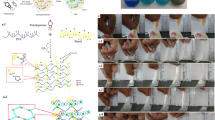Abstract
This study was a successful endeavor to develop and investigate the suitability of a bioadhesive wound-healing gel based on gelatin for first-aid purposes. Polyethylene glycol (PEG) was used to prepare a denser phase of gelatin chains, and diethyl ether (DEE) was used to introduce high volatility to the solution. The prepared solution was stable in the storage container but rapidly formed (within 3 s) a protective and bioadhesive gel around the wound surface by being sprayed over the wound. Besides, it also suppressed pain and showed moderate antimicrobial activity against S. aureus. It was also found highly biocompatible and non-toxic. All the results revealed that the prepared solution could be an effective candidate for treating minor injuries or burn, especially for a first-aid purpose.
Graphic abstract





Similar content being viewed by others
References
Adamic KJ, Greenbaum SG, Abraham KM, Alamgir M, Wintersgill MC, Fontanella JJ (1991) Lithium-7 NMR study of polymer electrolytes based on composites of poly [bis ((methoxyethoxy) ethoxy) phosphazene] and poly (ethylene oxide). Chem Mater 3(3):534–538
Bello AB, Kim D, Kim D, Park H, Lee S-H (2020) Engineering and functionalization of gelatin biomaterials: from cell culture to medical applications. Tissue Eng Part B Rev 26:164–180
Bhowmik S, Islam JMM, Debnath T, Miah MY, Bhattacharjee S, Khan MA (2017) Reinforcement of gelatin-based nanofilled polymer biocomposite by crystalline cellulose from cotton for advanced wound dressing applications. Polymers 9:222
Boateng JS, Matthews KH, Stevens HNE, Eccleston GM (2008) Wound healing dressings and drug delivery systems: a review. J Pharm Sci 97(8):2892–2923
Catalano E, Cochis A, Varoni E, Rimondini L, Azzimonti B (2013) Tissue-engineered skin substitutes: an overview. J Artif Organ 16:397–403
Chen J, Wang H, Mei L, Wang B, Huang Y, Quan G, Lu C, Peng T, Pan X, Wu C (2020) A pirfenidone loaded spray dressing based on lyotropic liquid crystals for deep partial thickness burn treatment: healing promotion and scar prophylaxis. J Mater Chem B 8(13):2573–2588
Daunton C, Kothari S, Smith L and Steele D (2012) A history of materials and practices for wound management. Wound Pract Res J Aust Wound Manage Assoc 20(4). https://search.informit.org/doi/10.3316/informit.058025628512911
Egert M, Simmering R (2016) The microbiota of the human skin. Microbiota Hum Body 61–81
Gaspar-Pintiliescu A, Stanciuc A-M, Craciunescu O (2019) Natural composite dressings based on collagen, gelatin and plant bioactive compounds for wound healing: a review. Int JBio Macro 138:854–865
Hawkins HK, Jay J, Finnerty CC (2018) 46-pathophysiology of the burn scar. In: Total burn care (5th edition). Elsevier, Berlin, pp 466–475
Hunt TK, Hopf H, Hussain Z (2000) Physiology of wound healing. Adv Skin Wound Care 13(2S):6–11
Jaipan P, Nguyen A, Narayan RJ (2017) Gelatin-based hydrogels for biomedical applications. MRS Commun 7(3):416–426
Joshi MP, Thipse SS (2019) Combustion analysis of a compression-ignition engine fuelled with an algae biofuel blend and diethyl ether as an additive by using an artificial neural network. Biofuels 2019:1–10
Khan MA, Islam JMM, Rahman M, Shekhar HU (2010) Preparation and in vivo study of an anti-infective highly volatile wound dressing material. Adv Mater Res Trans Tech Publ 2010:355–358
Khan MIH, Islam JMM, Kabir W, Rahman A, Mizan M, Rahman MF, Amin J, Khan MA (2016) Development of hydrocolloid bi-layer dressing with bio-adhesive and non-adhesive properties. Mater Sci Eng C 69:609–615
Lee JM, Chan ES, Ramanan RN, Ooi CW (2020) Liquid-liquid equilibria of aqueous two-phase systems made of polyethylene glycol and gelatin systems and their application in emulsion formation. Fluid Phase Equilib 508:112441
Li Y, Leng QQ, Pang XL, Shi H, Liu YL, Xiao SS, Zhao L, Zhou P, Fu SZ (2021) Therapeutic effects of EGF-modified curcumin/chitosan nano-spray on wound healing. Regener Biomater 8(2):1–9
Liesenfeld B, Moore D, Mikhaylova A, Vella J, Carr R, Schultz G and Olderman G (2009) Antimicrobial wound dressings-mechanism and function. In: Symposium on advanced wound care
Lin Z, Wu T, Wang W, Li B, Wang M, Chen L, Xia H, Zhang T (2019) Biofunctions of antimicrobial peptide-conjugated alginate/hyaluronic acid/collagen wound dressings promote wound healing of a mixed-bacteria-infected wound. Int J Biol Macromol 140:330–342
Neopane P, Nepal HP, Shrestha R, Uehara O, Abiko Y (2018) In vitro biofilm formation by staphylococcus aureus isolated from wounds of hospital-admitted patients and their association with antimicrobial resistance. Int J Gener Med 11:25–32
Pavlovič A, Libiaková M, Bokor B, Jakšová J, Petřík I, Novák O, Baluška F (2020) Anaesthesia with diethyl ether impairs jasmonate signalling in the carnivorous plant venus flytrap (Dionaea muscipula). Ann Bot 125(1):173–183
Rahman MF, Islam JMM, Hassan MM, Ahsan Habib SM, Pervez MS, Khan MA (2013) Development of urea crosslinked thin film for biomedical application. Int J Polym Mater Polym Biomater 62(13):695–699
Retnowati D, Sari R, Hendradi E, Septiani S (2021) The stability and irritability study of the chitosan–aloe vera spray gel as wound healing. J Basic Clin Physiol Pharmacol 32(4):651–656
Selvaraj D, Viswanadha VP, Elango S (2015) Wound dressings—a review. Biomedicine 5(4):22
Tanaka A, Nagate T, Matsuda H (2005) Acceleration of wound healing by gelatin film dressings with epidermal growth factor. J Vet Med Sci 67(9):909–913
Wayal V, Nagasree K, Vishwanath B (2021) Design, development and evaluation of silk based film forming spray for wound healing. J Drug Deliv Ther 11(3-S):15–18
Wu SC, Marston W, Armstrong DG (2010) Wound care: the role of advanced wound-healing technologies. J Am Podiatr Med Assoc 100(5):385–394
Zaman HU, Islam JMM, Khan MA, Khan RA (2011) Physico-mechanical properties of wound dressing material and its biomedical application. J Mech Behav Biomed Mater 4(7):1369–1375
Author information
Authors and Affiliations
Corresponding author
Ethics declarations
Conflict of interest
The authors declare no conflict of interest.
Ethical approval
This research does not require any ethical approval as there was no test was conducted on human or animal.
Additional information
Publisher's Note
Springer Nature remains neutral with regard to jurisdictional claims in published maps and institutional affiliations.
Rights and permissions
About this article
Cite this article
Islam, M.S., Islam, J.M.M., Rahman, M.F. et al. Gelatin-based instant gel-forming volatile spray for wound-dressing application. Prog Biomater 10, 235–243 (2021). https://doi.org/10.1007/s40204-021-00166-3
Received:
Accepted:
Published:
Issue Date:
DOI: https://doi.org/10.1007/s40204-021-00166-3




